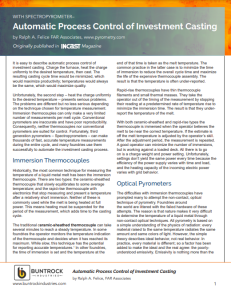Automatic Process Control of Investment Casting
It is easy to describe automatic process control of investment casting. Charge the furnace, heat the charge uniformly to the desired temperature, then cast. The resulting casting cycle time would be minimized, which would maximize productivity; temperatures would always be the same, which would maximize quality.
Unfortunately, the second step – heat the charge uniformly to the desired temperature – presents serious problems. The problems are different but no less serious depending on the technique chosen for temperature measurement. Immersion thermocouples can only make a very limited number of measurements per melt cycle. Conventional pyrometers are inaccurate and have poor reproducibility. Consequently, neither thermocouples nor conventional pyrometers are suited for control. Fortunately, third generation pyrometers – Spectropyrometers – can make thousands of fast, accurate temperature measurements during the entire cycle, and many foundries use them successfully to automate the investment casting process.
Immersion Thermocouples
Historically, the most common technique for measuring the temperature of a liquid metal melt has been the immersion thermocouple. There are two types: the ceramic-sheathed thermocouple that slowly equilibrates to some average temperature; and the rapid-rise thermocouple with electronics that stop measuring and present a temperature after a relatively short immersion. Neither of these is commonly used while the melt is being heated at full power. This means heating must be suspended for the period of the measurement, which adds time to the casting cycle.
The traditional ceramic-sheathed thermocouple can take several minutes to reach a steady temperature. In some foundries the operator monitors the temperature indication of the thermocouple and decides when it has reached its maximum. While slow, this technique has the potential for reporting accurate temperatures.1 In other foundries, the time of immersion is set and the temperature at the end of that time is taken as the melt temperature. The common practice in the latter case is to minimize the time of immersion to reduce the overall cycle time and maximize the life of the expensive thermocouple assembly. The result is that the temperature is often under-reported.
Rapid-rise thermocouples have thin thermocouple filaments and small thermal masses. They take the operator out of the timing of the measurement by stopping their reading at a predetermined rate of temperature rise to minimize the immersion time. The result is that they underreport the temperature of the melt.
With both ceramic-sheathed and rapid-rise types the thermocouple is immersed when the operator believes the melt to be near the correct temperature. If the estimate is off the melt temperature is adjusted by the operator’s skill. After the adjustment period, the measurement is repeated. A good operator can minimize the number of immersions, but is working against a loaded deck. All there is to go on is a charge weight and power setting. Unfortunately, settings don’t yield the same power every time because the efficiency of the power supply varies with time and load, and the heating capacity of the incoming electric power varies with grid behavior.
Optical Pyrometers
The difficulties with immersion thermocouples have prompted many to attempt the non-contact, optical technique of pyrometry. Foundries around the world are littered with the failed hardware of these attempts. The reason is that nature makes it very difficult to determine the temperature of a liquid metal through non-contact optical techniques. All pyrometry is based on a simple understanding of the physics of radiation: every material raised to the same temperature radiates the same amount and same colors of light. However, the simple theory describes ideal behavior, not real behavior. In practice, every material is different; so a factor has been added to make the ideal and the real agree: the poorlyunderstood emissivity. Emissivity is nothing more than the Originally published in Magazine www.buntrockindustries.com 2 Automatic Process Control of Investment Casting by Ralph A. Felice, FAR Associates efficiency of a radiator, and as such, varies between zero and one.



